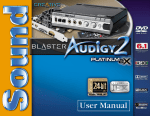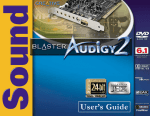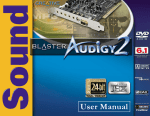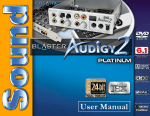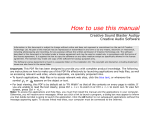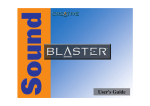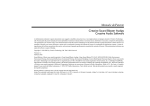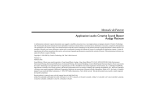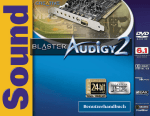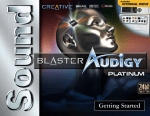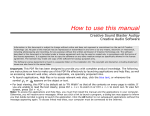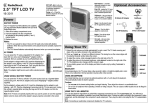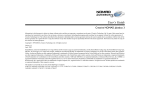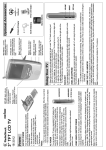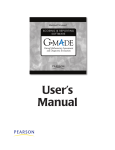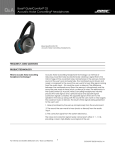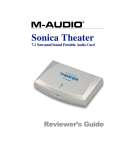Download Creative Sound Blaster Audigy 2 Platinum eX User's Manual
Transcript
User’s Guide Creative Sound Blaster Audigy 2 Platinum eX Information in this document is subject to change without notice and does not represent a commitment on the part of Creative Technology Ltd. No part of this manual may be reproduced or transmitted in any form or by any means, electronic or mechanical, including photocopying and recording, for any purpose without the written permission of Creative Technology Ltd. The software described in this document is furnished under a license agreement and may be used or copied only in accordance with the terms of the license agreement. It is against the law to copy the software on any other medium except as specifically allowed in the license agreement. The licensee may make one copy of the software for backup purposes only. The Software License Agreement is found in a separate folder on this installation CD. The copyright and disclaimer, including trademark issues are also found in the same folder. Copyright © 1998-2002 by Creative Technology Ltd. All rights reserved. Version 1.2 March 2003 Sound Blaster and Blaster are registered trademarks, and the Sound Blaster Audigy logo, the Sound Blaster PCI logo, EAX ADVANCED HD, Multi-Environment, Environment Panning, Environment Reflections, Environment Filtering, Environment Morphing, Creative Multi Speaker Surround, Inspire, and Oozic are trademarks of Creative Technology Ltd. in the United States and/or other countries. E-Mu and SoundFont are registered trademarks of E-mu Systems, Inc.. Cambridge SoundWorks, MicroWorks and PC Works are registered trademarks, and PC Works FourPointSurround is a trademark of Cambridge SoundWorks, Inc.. Microsoft, MS-DOS, and Windows are registered trademarks of Microsoft Corporation. Manufactured under license from Dolby Laboratories. "Dolby", "Pro Logic", "MLP Lossless", and the double-D symbol are trademarks of Dolby Laboratories. Confidential unpublished works. Copyright 1992-1998 Dolby Laboratories. All rights reserved. The FireWire logo is a trademark of Apple Computer, Inc.. THX is a registered trademark of THX Ltd.. All other products are trademarks or registered trademarks of their respective owners. This product is covered by one or more of the following U.S. patents: 4,506,579; 4,699,038; 4,987,600; 5,013,105; 5,072,645; 5,111,727; 5,144,676; 5,170,369; 5,248,845; 5,298,671; 5,303,309; 5,317,104; 5,342,990; 5,430,244; 5,524,074; 5,698,803; 5,698,807; 5,748,747; 5,763,800; 5,790,837. Important: This PDF file has been designed to provide you with complete product knowledge. The following are instructions on how to make use of this PDF file effectively by launching applications and help files, as well as accessing relevant web sites, where applicable, via specially prepared links. • To launch applications, Help files or to access relevant web sites, click the blue text, or whenever the symbol or appears on the object or text. • For best viewing, this PDF is by default set to "Fit Width" so that all the contents on every page is visible. If you are unable to read the text clearly, press Ctrl + <+> to zoom in or Ctrl + <-> to zoom out. To view full screen, press Ctrl + <L>. Note: To access the applications and Help files, you must first install the manual and the applications in your computer. Otherwise, you will receive error messages. When you click a link to launch a program, a dialog box may appear to inform you that Adobe Acrobat is going to launch the application. Click the All button to run subsequent applications without the message appearing again. To access linked web sites, your computer must be connected to the Internet. Contents Contents Introduction High-definition digital audio entertainment ................................................................................... i What is EAX ADVANCED HD? .............................................................................................................. ii Package Contents........................................................................................................................... iii System Requirements .................................................................................................................... iii Getting More Information ............................................................................................................. iv Visit the Soundblaster website ...................................................................................................... iv Technical Support ........................................................................................................................... v Document Conventions .................................................................................................................. v 1 About your Sound Blaster Audigy 2 Platinum eX hardware What You Need ........................................................................................................................................ 1-1 Your Sound Blaster Audigy 2 Platinum eX card.................................................................................... 1-2 Your Audigy 2 Platinum eX External I/O Module................................................................................. 1-3 Adjusting the volume-level of Headphones and Microphone................................................... 1-7 Using the Remote Control ....................................................................................................................... 1-8 Remote Control Functions....................................................................................................................... 1-9 2 Installing Hardware Installation Steps ...................................................................................................................................... 2-1 Step 1: Prepare the Sound Blaster Audigy 2 Platinum eX hardware........................................ 2-1 Step 2: Prepare your computer.................................................................................................... 2-2 Step 3: Install the audio card ....................................................................................................... 2-3 Step 4: Install the joystick............................................................................................................ 2-3 Step 5: Install the cables .............................................................................................................. 2-4 Step 6: Connect to AC power socket .......................................................................................... 2-6 Connecting Related Peripherals .............................................................................................................. 2-7 Connecting Related Peripherals (cont’d) ................................................................................................ 2-8 Connecting Speakers Systems...............................................................................................................2-11 Positioning Your Speakers.....................................................................................................................2-12 3 Installing Software Installing Drivers and Applications......................................................................................................... 3-1 Using Creative Software AutoUpdate..................................................................................................... 3-2 Sound Blaster Audigy 2 Feature Showcase Demo................................................................................. 3-2 Uninstalling and Reinstalling the Applications and Device Drivers ..................................................... 3-3 Reinstalling all Audio Drivers and Applications...................................................................... 3-3 Uninstalling all Audio Drivers and Applications ................................................................................... 3-3 Installing/Uninstalling selected Audio Drivers and Applications.......................................................... 3-4 Updating Windows 2000 (Service Pack 3)............................................................................................. 3-5 Updating Windows with Digital Video Update...................................................................................... 3-5 4 Using Audigy 2 Software Creative Sound Blaster Audigy 2 Applications...................................................................................... 4-1 Demos....................................................................................................................................................... 4-2 Sound Blaster Audigy 2 Getting Started Demo ......................................................................... 4-2 Sound Blaster Audigy 2 Feature Showcase Demo .................................................................... 4-2 Introduction to the Sound Blaster Audigy 2 software suite ................................................................... 4-3 Creative MediaSource Go!.......................................................................................................... 4-3 Creative MediaSource Go! Launcher ......................................................................................... 4-3 Creative MediaSource Player...................................................................................................... 4-4 “What-U-Hear” multichannel recording .................................................................................... 4-4 Creative MediaSource Organizer................................................................................................ 4-4 Creative MediaSource DVD-Audio Player................................................................................ 4-6 Creative EAX Console ................................................................................................................ 4-6 Creative Surround Mixer............................................................................................................. 4-8 Creative Speaker Settings............................................................................................................ 4-8 Creative Speaker Calibrator......................................................................................................... 4-8 Creative MiniDisc Center............................................................................................................ 4-9 Creative SoundFont Bank Manager............................................................................................ 4-9 Creative Audio Stream Recorder 2............................................................................................. 4-9 Creative Wave Studio.................................................................................................................4-10 Diagnostic and troubleshooting utilities................................................................................................4-10 Creative Diagnostics..................................................................................................................4-10 Creative Speaker Settings..........................................................................................................4-10 A General Specifications Features.................................................................................................................................................... A-1 Connectivity............................................................................................................................................. A-3 Sound Blaster Audigy 2 Platinum eX Card............................................................................... A-3 Sound Blaster Audigy 2 Platinum eX External I/O Module.................................................... A-4 B Troubleshooting and FAQs Problems Installing Software.................................................................................................................. B-1 Problems with Sound.............................................................................................................................. B-1 Problems with File Transfers on Some VIA Chipset Motherboards.................................................... B-5 Insufficient SoundFont Cache ................................................................................................................ B-6 Problems with the Joystick ..................................................................................................................... B-7 Problems with Multiple Audio Devices................................................................................................. B-8 Problems with Sound Blaster Live! Series or Sound Blaster PCI512 card.......................................... B-9 Resolving I/O Conflicts ........................................................................................................................ B-10 Problems with Encore DVD Player ..................................................................................................... B-11 Problems with Software DVD Player .................................................................................................. B-11 Problems with DV driver for Windows 98 SE/2000/Me/XP.............................................................. B-12 Problems in XP...................................................................................................................................... B-13 Problems with Digital Audio Devices.................................................................................................. B-14 Introduction Introduction High-definition digital audio entertainment Thank you for purchasing Sound Blaster® Audigy™ 2 Platinum eX, consisting of the Sound Blaster Audigy 2 Platinum eX card, the Sound Blaster Audigy 2 Platinum eX External I/O Module and an IR remote control. It is the most complete affordable high-definition digital audio entertainment solution you can find on the market today. Sound Blaster Audigy 2 has received the prestigious THX Multimedia Certification award, making it the perfect choice for PC audiophiles seeking the very best music and movie experiences. MLP (Meridian Lossless Packing), the method of audio data compression used in DVD-Audio, reduces file size without removing any of the information contained in the original recording. The listening audience will hear the audio as it was intended in the original recording. Other packing methodologies that remove data as part of the compression are referred to as 'Lossy Compression'. Featuring 24-bit/192 kHz audio playback feature, Sound Blaster Audigy 2 Platinum eX delivers highdefinition sound of astounding quality with 24-bit/96 kHz audio recording capability from all Line Ins and SPDIF In. Sound Blaster Audigy 2 Platinum eX supports 6.1 channel Dolby® Digital Surround EX surround sound audio on your computer and 5.1 output from the 96 kHz sampling rates of DVD-Audio discs using MLP lossless compression. The External I/O Module provides front panel access to microphone, headphone, input/output, and MIDI connections — all located away from your computer and closer to your work area. The Sound Blaster Audigy 2 Platinum eX is the only Audigy 2 product with ASIO driver support for 24-bit/96 kHz recording - allowing musicians to produce high quality works. Additionally, an IEEE 1394-compliant SB1394™/ FireWire® connection is provided for high-speed connectivity to NOMAD® portable digital audio players, external CD-RW drives and other IEEE 1394 compatible devices like DV Camcorders, printers, scanners, and digital still cameras. The infrared remote control offers convenient control of your computer for tasks like playing audio or video CDs, at distances up to four meters (13 feet). Introduction i What is EAX ADVANCED HD? EAX® ADVANCED HD™ brings a new level of performance, power, and flexibility to PC audio. Taking advantage of the increased processing capabilities of the Sound Blaster Audigy 2 processor, EAX ADVANCED HD delivers a host of new features to achieve high definition audio for gaming and music enhancement. The EAX ADVANCED HD Game Audio Library takes in-game audio and acoustic simulation to a whole new level. These innovative technologies bring tremendous realism and total audio immersion to PC gamers: ❑ New Multi-EnvironmentTM technology renders multiple environment audio environments in real time. ❑ Environment PanningTM makes it easy for gamers to track with three-dimensional precision, the location and movement of sounds that usually represent enemies or team mates. This gives Sound Blaster Audigy 2 gamers a better advantage as they are more aware of the game environment. ❑ Environment ReflectionsTM offers localization of early reflections and echoes such as reflections created by canyon walls or cliffs. ❑ Environment FilteringTM simulates the propagation of sound in both indoor and outdoor game arenas. ❑ Environment MorphingTM allows for seamless transitions from one environment to the next. EAX ADVANCED HD Music Technologies also ensures sonic superiority: ❑ Audio Clean-Up removes unwanted noise in a digital audio file. ❑ Time Scaling speeds up and slows down music without distortion. ❑ EAX ADVANCED HD music effects, developed especially for music listening, further enhance playback of songs. EAX ADVANCED HD offers dramatically increased 3D audio performance and functionality. Delivering superior audio fidelity and sophisticated reverb effects, this unsurpassed digital entertainment experience is available only from the Sound Blaster Audigy 2 family of products. Introduction ii Package Contents The items listed here may vary from country to country. The following items are included in your package: ❑ Sound Blaster Audigy 2 Platinum eX card ❑ Sound Blaster Audigy 2 Platinum eX External I/O Module and IR remote control ❑ AD_LINK cable ❑ Power converter Cable ❑ Joystick/MIDI bracket ❑ 3.5 mm minijack to ¼” plug adapter ❑ Two AAA batteries for the IR remote control ❑ Sound Blaster Audigy 2 Installation and Applications CD ❑ Sound Blaster Audigy 2 Feature Showcase Demo CD ❑ Creative DVD-Audio Sampler Disc ❑ Quick Start leaflet ❑ User’s Guide (on CD) ❑ Warranty (printed or on CD) ❑ Technical Support (printed or on CD) System Requirements Sound Blaster Audigy 2 Platinum eX hardware ❑ Genuine Intel® Pentium® II 350 MHz, AMD® K6 450 MHz or faster processor for SB1394/FireWire applications or games ❑ Intel, AMD or 100% compatible motherboard chipset ❑ Windows® 98 Second Edition (SE), Windows Millennium Edition (Me), Windows 2000 Service Pack 2 (SP2) or Windows XP ❑ 64 MB RAM for Windows 98 SE and Windows Me 128 MB RAM for Windows 2000 (SP2) and Windows XP ❑ 600 MB of free hard disk space ❑ Available PCI 2.1 compliant slot for the audio card ❑ Available space for the included joystick/MIDI bracket (optional) Introduction iii ❑ Headphones or amplified speakers (available separately) ❑ At least one CD-ROM/CD-RW or DVD-ROM drive installed SB1394/FireWire applications, games, DVD audio and video Minimum 256 MB RAM recommended for Windows 2000 SP3 and Windows XP users for games and DV capture and editing. ❑ Genuine Intel Pentium III 500 MHz, or AMD 700 MHz processor for SB1394/FireWire applications or games ❑ SB1394/FireWire: minimum 128 MB RAM and 1 GB workspace for digital video (DV) capture and editing. For DV applications, recommended minimum is an Ultra DMA hard disk with 6 GB workspace (ATA-100, 7,200 rpm type). ❑ Games: At least 128 MB RAM, 3D graphics accelerator with at least 8 MB of texture RAM, available 300–500 MB of free hard disk space ❑ DVD: At least second generation DVD-ROM drive with these recommended soft-DVD players: InterVideo’s WinDVD 2000 or CyberLink’s PowerDVD 3.0 or later ❑ DVD-Audio: Pentium III or AMD Athlon 1 GHz or faster processor recommended. Requires 256 MB RAM for Windows 98 SE, Windows Me, Windows 2000 SP3 or Windows XP SP1, Also requires a second-generation 6X or faster DCD-ROM drive. Visit www.soundblaster. com for updates on OS-specific support issues. Internet multimedia and entertainment Internet Radio: requires at least a 56 kbps modem and an active Internet connection to run the application Getting More Information Refer to the Sound Blaster Audigy 2 Getting Started demo and the various online Help files for detailed information on Creative applications. The Sound Blaster Audigy 2 Feature Showcase demo gives you an interactive introduction to Sound Blaster Audigy 2 and demonstrates the card’s capabilities. Visit the Soundblaster website View the contents of the Sound Blaster Audigy 2 Installation and Applications CD for additional libraries and other software. Visit the www.soundblaster.com site for the latest Sound Blaster news and products. The site also includes information on making purchases, technical help, and http://www.soundblaster.com/ support for the automated driver download and installation. Other Internet applications may have higher system requirements or may require a microphone. Refer to the application’s online Help documentation for details. Introduction iv Technical Support Visit http://www.soundblaster.com/support/faq/ for general help. Document Conventions The following typographical conventions are used throughout this manual: The notepad icon indicates information that is of particular importance and should be considered before continuing. The alarm clock designates a caution or warning that can help you avoid situations involving risk. The warning sign indicates that failure to adhere to directions may result in bodily harm or life-threatening situations. Introduction v 1 About your Sound Blaster Audigy 2 Platinum eX hardware About your Sound Blaster Audigy 2 Platinum eX hardware What You Need Before you begin installation, be sure that you have these: In addition, you will also need an available PCI slot and another adjacent available slot on your computer. Sound Blaster Audigy 2 Platinum eX card AD_LINK cable Joystick/MIDI bracket Figure 1-1: Audigy 2 Platinum eX External I/O Module Power Converter Cable Phillips-head screwdriver (not included) What you need. About your Sound Blaster Audigy 2 Platinum eX hardware 1-1 Your Sound Blaster Audigy 2 Platinum eX card Your audio card has these jacks and connectors to enable the attachment of a wide variety of devices: 7 6 Click any circled number in the diagram to see a description of the item. The Audigy 2 Platinum eX card works as a stand-alone audio card. However to enjoy all the features available, you need to connect it to the External I/O Module. 5 1 4 3 Figure 1-2: 2 Jacks, connectors and ports About your Sound Blaster Audigy 2 Platinum eX hardware 1-2 Your Audigy 2 Platinum eX External I/O Module Your Sound Blaster Audigy 2 Platinum eX External I/O Module has these jacks, connectors and controls: 1 2 3 5 4 6 7 8 9 Click any circled number in the diagram to see a description of the item. 10 • To connect your existing computer headphones and microphone to the External I/ O Module, use a 3.5 mm (1/ 8”) minijack to 1/4” plug adapter. • Set the gain level of the Mic In 2 jack to the minimum before connecting or turning on a microphone, especially if you are using headphones. 11 Figure 1-3: 12 13 14 15 Jacks, connectors and controls. About your Sound Blaster Audigy 2 Platinum eX hardware 1-3 Table 1: The Sound Blaster Audigy 2 Platinum eX card Click here or on any description to return to the diagram of the Sound Blaster Audigy 2 Platinum eX card. Number Description 1 Joystick/MIDI connector Connects to the Joystick/MIDI bracket for gamepads, other input and MIDI devices. 2 AD_LINK 2 port Connects to the External I/O Module’s AD_LINK2 port to supply power. 3 AD_LINK 1 connector Connects to the External I/O Module for transferring data. 4 Line Out 3 jack Connects to Front Center, subwoofer and Rear Center inputs of powered analog speakers or an external amplifier. 5 Line Out 2 jack Connects to Rear Left/Right analog inputs of powered analog speakers or an external amplifier. 6 Line Out 1 jack Connects to Front Left/Right analog input of an external amplifier or to powered analog speakers, or headphones. 7 Power Connector Connects to the supplied power converter cable. 8 Aux_In connector Connects to an analog output of a CD or DVD-ROM drive. 9 CD_SPDIF connector Connects to the digital output of a CD or DVD-ROM drive. About your Sound Blaster Audigy 2 Platinum eX hardware 1-4 Table 2: Audigy 2 Platinum eX External I/O Module Number Description 1 SB1394/FireWire port Connects to an IEEE 1394 compatible external device (such as a digital video camcorder, digital still camera, printer or scanner). 2 Optical SPDIF Out/In For recording/playback devices with optical connectors. 3 Line In 2 jack For analog devices like music synthesizers and other line-level sources. 4 Line In 1/Mic In jack For line sources (for example, electric guitars) or dynamic microphones. 5 ¼-inch Headphone jack For connecting to headphones. (Speaker output will be muted). 6 Microphone Input Sensitivity control knob Controls the input level of a microphone signal. 7 Master Volume control knob Controls the overall output volume. 8 CMSS Switch Turns the Creative MediaSource MultiSpeaker Surround® feature on or off. 9 Infrared Receiver Lets you control your computer via the IR remote control. Click here or on any description to return to the diagram of the External I/O Module. About your Sound Blaster Audigy 2 Platinum eX hardware 1-5 Table 2: Audigy 2 Platinum eX External I/O Module Number Click here or on any description to return to the diagram of the External I/O Module. Description 10 Line In 3 (Aux In) jacks Connects to analog devices like VCRs, TVs and CD players. 11 Standard MIDI In/Out connectors Connects to MIDI devices via standard DIN cables. 12 SPDIF In/Out Coaxial jacks For digital audio recording/playback devices such as DAT and MiniDisc recorders. 13 SPDIF Digital Out Mini DIN jack Outputs digital audio via mini DIN cable. 14 AD_LINK 1 Connector Connects to the Sound Blaster Audigy 2 Platinum eX card's AD_LINK 1 cable's connector. 15 AD_LINK 2 Connector (SB1394/FireWire port) Connects to the Sound Blaster Audigy 2 Platinum eX card's AD_Link 2 connector via the supplied 1.8 meter (5-feet) AD_LINK cable. It provides power to the External I/O Module. Next to AD_LINK 2 is another SB1394/ FireWire port, for connection to IEEE1394-compatible devices. About your Sound Blaster Audigy 2 Platinum eX hardware 1-6 Adjusting the volume-level of Headphones and Microphone You can adjust the headphones volume and microphone gain in two ways. Using the control knobs On the front panel of the External I/O Module, turn the respective control knob: ❑ Counterclockwise to decrease the headphone volume or microphone gain. ❑ Clockwise to increase the headphone volume or microphone gain. About your Sound Blaster Audigy 2 Platinum eX hardware 1-7 Using Creative Surround Mixer To install Creative Surround Mixer and other applications, see “Installing Drivers and Applications” on page 3-1. • For best effects, set the headphones volume and microphone gain levels to 75% in Surround Mixer, and then use the Audigy 2 Platinum eX External I/O Module’s control knobs to make further adjustments. • If you set the headphones volume or microphone gain levels to 0%, or mute them in Creative Surround Mixer, you hear no sound even if the Sound Blaster Audigy 2 Platinum eX External I/O Module’s control knobs are set to the maximum. Using the Remote Control To adjust headphones volume: 1. Click Start -> Programs -> Creative -> Sound Blaster Audigy 2 -> Surround Mixer. 2. On the Master Control panel of Creative Surround Mixer, make sure that there is no red “X” on the Speaker button under the Volume slider. Otherwise, click the Speaker button. This will unmute the headphones output. 3. Drag the Volume slider up or down to adjust the headphones volume. To adjust microphone gain: 1. Click Start -> Programs -> Creative -> Sound Blaster Audigy 2 -> Surround Mixer. 2. On the Source panel of Creative Surround Mixer, click an audio input source button with a down arrow, and then select Line-In 1/Mic. 3. Make sure the Speaker button below the Line-In 1/Mic slider has no red “X” on it. Otherwise, click the Speaker button. This will unmute the audio input. 4. Drag the slider to adjust the microphone gain. The external External I/O Module has an infrared receiver for the remote control. This remote control lets you operate your computer from the comfort of your sofa or bed up to a distance of 4 meters (13 feet). About your Sound Blaster Audigy 2 Platinum eX hardware 1-8 Remote Control Functions • *OSD - On Screen Display. • The model of your remote control may be different from the unit displayed here. Refer to Figure 1-4 and Figure 1-5 below for a description of your remote control’s functions. Number pad Used for the selection of tracks and menu items. To access a two-digit number track such as track 10, press the "1" button followed by the "0" button in quick succession. During playback of a media format, press the "0" button to display the track list on the OSD* for selection. Play/Pause button Starts, pauses or resumes the current playback. Record button Starts audio recording. Up/Down buttons Used for navigating up/ down. Rewind/Left button Used for rewinding a track, decreasing a value or navigating left. Fast Forward/ Right button Use this to cue forward through a track, or increase a value or navigate right. Select/OK button Executes a selected task or command. During playback of a media format, press this button to display the content menu on the OSD* for selection. Next button Goes to the next track or menu page. Stop/Eject button Stops the current playback. Pressing the button subsequently will eject the disc. Previous button Goes to the previous track or menu page. Slow Motion Forward button Reduces the playback speed (except for audio CDs and MIDI files). Press repeatedly to select the speed. Press the Play/Pause button to resume normal playback. Step Forward button (For video only) Press once to pause playback. Pressing the button each time will advance you to the next video frame. To resume normal playback, press the Play/Pause button. Figure 1-4: Navigation Buttons on the Remote Control. About your Sound Blaster Audigy 2 Platinum eX hardware 1-9 Display button Displays the current task status, and the time and date on the OSD. EAX button Displays the EAX-specific OSD menu. Power button Displays the Shutdown Menu Options button Displays options for current task. CMSS button Press to select CMSS mode. Return button Returns to parent menu. Close/Cancel button Cancels the current OSD menu or closes the application currently being controlled by the remote control. Start button Displays the OSD Start menu for the selection of a task. Mute button Press to mute audio. Master Volume buttons Press the Volume Up (+) or Volume Down (-) button to control the master volume of your computer and Sound Blaster Audigy 2 Platinum eX. Figure 1-5: Other Buttons on the Remote Control. About your Sound Blaster Audigy 2 Platinum eX hardware 1-10 2 Installing Hardware This chapter tells you how to install the Sound Blaster Audigy 2 Platinum eX hardware. Installing Hardware Installation Steps Step 1: Prepare the Sound Blaster Audigy 2 Platinum eX hardware 1. Place the Sound Blaster Audigy 2 Platinum eX External I/O Module near your computer. 2. Locate the AD_LINK cable that links your External I/O Module to your Sound Blaster Audigy 2 Platinum eX card. Turn off the main power supply and disconnect your computer’s power cord. Systems using an ATX power supply unit with soft power off may still be powering the PCI slot. This can damage your audio card when it is inserted into the slot. Figure 2-1: Audigy 2 Platinum eX External I/O Module and AD_LINK cable Installing Hardware 2-1 Step 2: Prepare your computer 1. Turn off your computer and all peripheral devices. 2. Touch a metal plate on your computer to ground yourself and to discharge any static electricity, and then unplug the power cord from the wall outlet. 3. Remove the computer cover. 4. Remove the metal brackets from two adjacent unused PCI slots as shown in Figure 2-2. Remove any existing audio card or disable the onboard audio. For more information, see “Troubleshooting and FAQs” on page B-1. Remove screws (if any) and put aside for securing the audio card’s metal bracket. metal bracket PCI slot ISA slot (on older mainboards) Figure 2-2: Removing metal brackets Installing Hardware 2-2 Step 3: Install the audio card 1. Align the audio card with the PCI slot and press the card gently but firmly into the slot as shown in Figure 2-3. 2. Do not force the audio card into the slot. Make sure that the gold traces of the card’s PCI connector are aligned with the PCI bus connector on the motherboard before you insert the card into the PCI expansion slot. If it does not fit properly, gently remove it and try again. 3. Secure the audio card to the computer. PCI slot Figure 2-3:Aligning the card against the slot. Step 4: Install the joystick connector 1. Align the joystick connector bracket next to the audio card. 2. Secure the Joystick bracket with a screw (if necessary). See Figure 2-4. Figure 2-4: Installing the joystick port Installing Hardware 2-3 Step 5: Install the cables To use the front and back SB1394/ FireWire connectors on the External I/O Module, you must connect the AD_LINK 1 and AD_LINK 2 connectors on both the audio card and the External I/O Module. 1. Connect the AD_LINK 1 connectors on the AD_LINK cable first. With the connector’s side springs pressed down, push the connector until it clicks firmly into place on both the audio card and the External I/O module. 2. Connect the AD_LINK 2 connectors at both ends. See Figure 2-5. 3. Locate the supplied power converter cable. Insert the small white connector into the audio card's power connector. 4. Connect the other end of the power convertor to an available power supply cable from your computer's power supply unit. Note: Make sure that the power cable connected to the audio card is not shared with other devices like disk drives. To system power supply unit CD-ROM or DVDROM drive 4 5 3 If your computer chassis blocks the AD_LINK cable from connecting to the audio card: 1) Unscrew and loosen the card from the PCI slot 2) Insert the AD_LINK cable 3) Reinstall the card securely into the PCI slot. 6 CD_SPDIF connector Power converter cable and connector If the AD_LINK cable is too long, coil it gently to prevent damage to the delicate wires inside the cable. Side spring Figure 2-5: 1 2 Connecting the cables to the audio card. Installing Hardware 2-4 Windows 98 SE users can also listen to audio CDs via Windows Media Player 7.x or later, using the Digital Playback option. Your CD-ROM/DVD-ROM drive must support sustained digital reads. Read the Media Player help for more information. Digital CD Audio Extraction On a fresh installation of Windows Me, you may not hear audio from your CD-ROM drive even after enabling Digital CD Audio. To solve this, disable Digital CD Audio and then restart the computer. When the system has restarted, re-enable Digital CD Audio and restart the system again. 5. Connect your CD-ROM or DVD drive’s analog audio output cable to the Audigy 2 Platinum eX card’s Aux_IN connector. 6. If your CD-ROM or DVD drive has a digital SPDIF audio output connector, you may wish to skip Step 5 and use a two-pin digital audio cable (available separately) to connect the drive to the Audigy 2 Platinum eX card’s CD_SPDIF connector instead, for better sound quality. Note: Audio can be sent to your computer through your CD or DVD drive’s IDE cable instead, through a feature called Digital CD Audio Extraction. See “Digital CD Audio Extraction” below if you wish to use this feature. To enable this feature in Windows Me or Windows 2000 (enabled by default in Windows XP), follow the steps below: 1. In Windows 2000/XP or Windows Me, click Start -> Settings-> Control Panel -> System. 2. Select the Device Manager tab. 3. Double-click the CD-ROM or DVD-ROM icon. Doubleclick the name of your drive. 4. In the Properties tab, click the “Enable Digital CD audio for this CD-ROM device” checkbox to select it. Figure 2-6: Enabling Digital CD Audio in Windows 2000 Installing Hardware 2-5 Step 6: Connect to AC power socket 1. Replace the computer cover. 2. Plug the power cord into the AC wall outlet, and turn on the computer. To connect your Sound Blaster Audigy 2 Platinum eX card and External I/O Module to other devices, see “Connecting Related Peripherals” on page 2-7. To install software. refer to “Installing Drivers and Applications” on page 3-1. Installing Hardware 2-6 Connecting Related Peripherals Sound Blaster Audigy 2 Platinum eX will give you endless hours of listening pleasure. Figure 2-7 shows you how to connect related peripherals to your Sound Blaster Audigy 2 Platinum eX to optimise your enjoyment. 1 2 3 Click any circled number in the diagram to see a description of the item. The supplied AD_LINK cable consists of two connectors (AD_LINK 1 and AD_LINK 2) at both ends. AD_LINK 1 transfers data while AD_LINK 2 provides power via an IEEE1394 connection. 7 6 4 Analog Source 5 Figure 2-7: Connecting Sound Blaster Audigy 2 Platinum eX to other devices. Installing Hardware 2-7 Connecting Related Peripherals (cont’d) 1 Click any circled number in the diagram to see a description of the item. 2 3 4 7 or 6 Other IEEE 1394 devices you can connect: •IEEE 1394 hard disk •IEEE CD-RW drive •SB 1394/Firewire NOMAD Jukebox •IEEE-compliant 1394 devices 5 Dolby Digital (AC-3) Amplifier SPDIF In Figure 2-8: Connecting peripherals to the External I/O Module. Installing Hardware 2-8 Table 1: Description of components on Page 2-7 Number Click here or on any description in the table to return to the main diagram. Description 1 Surround Amplifier or powered speakers Multichannel analog audio-video amplifier or 5.1/6.1 analog multi-speaker system, or ordinary stereo receiver. 2 Line Out 1 jack Connects to powered stereo speakers or an external amplifier. Also supports headphones. Outputs front Left/Right audio channels. 3 Line Out 2 jack Connects to powered surround speakers or an external surround amplifier with surround inputs. Outputs Surround Left/Right audio. 4 Line Out 3 jack Three-channel analog jack outputs Subwoofer, Front Centre and Rear Centre signals. A 4-pole 3.5mm plug is required. 5 Digital Audio device Devices like DAT or MD players that have a 3.5mm input jack. 6 Coaxial Analog Line In jacks Connect to external analog stereo devices like cassette recorders, tuners or other linelevel sound sources. 7 SPDIF Digital Out jack Outputs up to 6.1-channels or compressed AC-3 SPDIF output for connection to digital surround decoders and amplifiers or digital speaker systems, like the Creative Inspire 5.1TM speaker system. Installing Hardware 2-9 Table 2: Description of components on Page 2-8 Number Click here or any description in the table to return to the main diagram Description 1 Optical Input/Output Connect to digital recording/playback devices with TOSLINK optical input and output connectors. 2 Line In 1/Mic In jack Connects to analog line-level devices like electric guitars, or microphones. 3 1/8-inch Headphone jack Connects to stereo headphones with 3.5mm (1/8-inch) jack. Use a convertor if your headphones come with a smaller connector. 4 Digital Video camcorder or other IEEE 1394 device Connect IEEE-compliant 1394/Firewire devices like Digital Video camcorders or the NOMAD Jukebox. 5 Mini DIN SPDIF connector Found on Creative digital speaker systems like the Creative Inspire 5.1™, which can be connected to the External I/O Module’s SPDIF Digital Output via a Mini DIN-tomini plug convertor. 6 MIDI In/Out connectors Connect to MIDI devices like synthesizers, etc. MIDI devices can be daisy-chained if they have both MIDI In and MIDI Out jacks. 7 Digital Recording Device Connect to external digital playback and record stereo devices such as another Creative audio card, or DAT recorder. Installing Hardware 2-10 Connecting Speakers Systems If you have a 5.1 or 6.1 channel speaker system, you can “upmix” your stereo sources (such as MP3, WMA, MIDI and Wave) to 6.1 channels by using the Creative MultiSpeaker Surround (CMSS) technology. To upmix, you need to enable the CMSS feature in Creative EAX console. Refer to the EAX ADVANCED HD online Help. Surround amplifier or speaker system with analog 5.1 inputs For discrete 7-channel amplifiers or systems, use a 3.5 mm (stereo) Audio/Video-to-RCA cable (available separately) to connect Line Out 3 to available Center, Subwoofer and Rear Center channels. For connection to center and subwoofer channels using a 3.5 mm (stereo)-to-RCA cable or 3.5 mm (stereo) Audio/Video-toRCA cable (available separately), connect the white RCA jack to the Center input, and the red RCA jack to the Subwoofer input. Rear Center connectors for use in 6.1-channel systems only 3.5 mm (mono)-to-3.5 mm (mono) digital cable Line Out 1 (Analog) Line Out 2 (Analog) Line Out 3 (Analog) For 5.1-channel systems, Line Out 1, 2 and 3 require a standard 3-pole mini plug. For 6.1-channel systems, Line Out 3 requires a 3.5mm stereo Audio/Video plugto-RCA jack for output of Center, Subwoofer and Rear Center signals. Right channel, Left channel for twochannel output Subwoofer, Center and Rear Center for threechannel output Dolby Digital Decoder/Amplifier Figure 2-9: Connecting external consumer electronic devices to the Sound Blaster Audigy 2 Platinum eX. Installing Hardware 2-11 Positioning Your Speakers Good speaker placement can enhance your movie enjoyment, while careless placement can make good audio systems sound bad. For detailed loudspeaker placement tips visit the Dolby Laboratories website at http:// www.dolby.com/ht/co_br_0110_ ListenersGuideEX.html If you are using four to six speakers, place them to form a circle around you (Figure 2-10), and the speakers angled toward you. Make sure that the computer monitor is not blocking the path of your front speakers. You may want to adjust the relative positions of the speakers until you get the audio experience you like best. If you have a subwoofer, place the unit near a corner of the room for the best bass experience. Speaker notation SW CS FL FR FL: Front Left CS: Front Center FR: Front Right RL: Rear Left RC: Rear Center RR: Rear Right SW: Subwoofer RC RL Figure 2-10: RR Recommended speaker placement. Installing Hardware 2-12 3 Installing Software This chapter tells you how to install the Sound Blaster Audigy 2 Platinum eX software. Installing Software Installing Drivers and Applications • During the installation process, Windows 98 SE users may be prompted to insert the Windows 98 SE installation CD into the CD-ROM drive. Do so and click the OK button. • Some computers may be supplied without the Windows 98 SE CD, but have the necessary files stored in C:\Windows\Options\Cabs (where C: represent the drive Windows has been installed on). You need to install device drivers and applications prior to using Sound Blaster Audigy 2 Platinum eX. To install these drivers and the selected software applications, use the following instructions. The instructions are applicable to all supported Windows operating systems. 1. After you have installed the Sound Blaster Audigy 2 Platinum eX card and Audigy 2 Platinum eX External I/O Module, turn on your computer. Windows automatically detects the audio card and device drivers. 2. When prompted for the audio drivers, click the Cancel button. 3. Insert the Sound Blaster Audigy 2 Installation and Applications CD into your CD-ROM drive. If your system’s Windows AutoPlay mode is enabled, the CD starts running automatically. If not, you need to enable your CD-ROM drive’s auto-insert notification feature. For more details, see “Problems Installing Software” on page B-1. 4. Follow the instructions on the screen to complete the installation. 5. When prompted, restart your computer. Downloading the latest applications and device drivers from the Internet is easier than ever with Creative Software AutoUpdate. See “Using Creative Software AutoUpdate” on page 3-2 for details. Installing Software 3-1 Using Creative Software AutoUpdate Locating, downloading and installing updates for your Creative Products is now simpler and faster with the new web-based Creative Software AutoUpdate system. Instead of spending valuable time searching for individual files to download and install for each of your installed Creative Products, let Creative Software AutoUpdate do the work for you. When you connect to Creative Software AutoUpdate via the Internet, the website will analyze your computer system to determine what operating system (OS), language and Creative products are installed in your system. For your privacy, no personal information is captured by or sent to Creative Labs during the Software AutoUpdate process. Only system information and Creative product details are required for the AutoUpdate analysis. None of this information can or will be used by Creative for any other purpose. After the online analysis, you will be able to select from a list of only the most relevant software and driver updates. The files will then be dynamically retrieved and installed on your system for you. As the files are customised for your specific OS, language and Creative hardware, they are smaller and take less time to download, compared to the huge generic multi-language files available via non-customised software downloads. Points to note: ❑ First-time users of Creative Software AutoUpdate may be prompted to authorise the download of a browser component required for system inspection. Ensure that the content is signed by Creative Labs, Inc., and then click the Yes button. ❑ Ensure that all your Creative products are connected and installed on the same computer running Creative Software AutoUpdate. To find out more about Creative Software AutoUpdate, visit www.soundblaster.com. Sound Blaster Audigy 2 Feature Showcase Demo To feel the audio card’s awesome gaming, music reproduction and home studio capabilities, install the Sound Blaster Audigy 2 Feature Showcase Demo. This demo requires high-quality 5.1/6.1 speaker for optimal listening experience. 1. Insert the Sound Blaster Audigy 2 Feature Showcase Demo CD into your CD-ROM drive. If the drive supports Windows AutoPlay mode, the CD starts running automatically. If not, you need to enable your CD-ROM drive’s auto-insert notification feature. For more details, see “Problems Installing Software” on page B-1. 2. Follow the instructions on the screen to complete the installation, and to run the Demo. Installing Software 3-2 Uninstalling and Reinstalling the Applications and Device Drivers At times you may need to uninstall or reinstall some or all of the audio card's applications and device drivers to correct problems, change configurations, or upgrade outdated drivers or applications. The following instructions tell you how to do so in all Windows operating systems. Reinstalling all Audio Drivers and Applications If you are experiencing problems with the Audigy 2 device drivers or application, you may want to reinstall all of them. To do so: 1. Click Start -> Settings -> Control Panel. 2. Double-click the Add/Remove Programs icon. 3. Click the Install/Uninstall tab or the Change or Remove Programs button. 4. Select the Sound Blaster Audigy 2 entry, and then click the Add/Remove (or Change/Remove) button. 5. In the InstallShield Wizard dialog box, select the Repair option. If prompted, insert the Sound Blaster Audigy 2 Installation and Applications CD into your CD-ROM and click the OK button. 6. Click the Yes button. 7. Restart your computer when prompted. Before you begin, close all audio card applications. Applications that are still running during the uninstallation will not be removed. You can now check the computer to see if the reinstalled software works properly. If not, proceed to “Troubleshooting and FAQs” on page B-1. Uninstalling all Audio Drivers and Applications For a cleaner installation, you may want to uninstall all the audio drivers and applications before you reinstall them again. To do so: 1. Click Start -> Settings -> Control Panel. 2. Double-click the Add/Remove Programs icon. 3. Click the Install/Uninstall tab or Change or Remove Programs button. 4. Select Sound Blaster Audigy 2 entry, and then click the Add/Remove (or Change/Remove) button. Installing Software 3-3 5. In the InstallShield Wizard dialog box, select the Remove option. 6. Click the Yes button. 7. Restart your computer when prompted. To uninstall Creative MediaSource and all its components, do the following: 1. Click Start -> Settings -> Control Panel. 2. Double-click the Add/Remove Programs icon. 3. Click the Install/Uninstall tab (or Change or Remove Programs button). 4. Select Sound Blaster Audigy 2 entry, and then click the Add/Remove (or Change/Remove) button. 5. In the InstallShield Wizard dialog box, select the Full Uninstallation button, and then click the Next button. 6. Click the Yes button. 7. Restart your computer when prompted. Installing/ Uninstalling selected Audio Drivers and Applications The above instructions helped you to install or uninstall all device drivers or applications. However, you can also install or uninstall only selected drivers or applications. To do so: 1. Click Start -> Settings -> Control Panel. 2. Double-click the Add/Remove Programs icon. 3. Click the Install/Uninstall tab (or the Change or Remove Programs button) 4. Select Sound Blaster Audigy 2 entry, and then click the Add/Remove (or Change/Remove) button. 5. In the InstallShield Wizard dialog box, select the Modify option. A list of applications appears. 6. To uninstall an application, click the check box adjacent to it so that the box is clear. To install an application, click the adjacent check box so that a tick/cross appears within it. 7. Click the Next button. If prompted, insert the Sound Blaster Audigy 2 Installation CD into your CDROM, and click the OK button. 8. Restart your computer when prompted. Installing Software 3-4 To uninstall a selected component in Creative MediaSource, do the following: 1. Click Start -> Settings -> Control Panel. 2. Double-click the Add/Remove Programs icon. 3. Click the Install/Uninstall tab (or the Change or Remove Programs button) 4. Select the Creative MediaSource entry, then click the Add/Remove (or Change/Remove) button. 5. In the InstallShield Wizard dialog box, click the Custom Uninstallation button, and then click the Next button. 6. Click the check box of the application that you want to uninstall, to select it. 7. Click the Next button. 8. Restart your computer when prompted. Updating Windows 2000 (Service Pack 3) Windows 2000 now provides better support for AC-3 SPDIF output (non-PCM through WaveOut) for software DVD viewing. Click the web site link below to download the Windows 2000 Service Pack 3 to enjoy this support and to fix other issues in the Windows 2000 OS. Updating Windows with Digital Video Update If you have installed DirectX 8.0 or 8.0a run time, install the latest update for this application. If DirectX 8.1 has been installed, users do not need the update. http://www.microsoft.com/ This update provides PAL support and improved device support to 1394 Digital Video equipment users This is applicable for Windows 98 SE and Windows 2000 users. This update provides minor improvement to the Windows Me OS. To look for this update, go to the web site below. http://www.microsoft.com/ Installing Software 3-5 4 Using Audigy 2 Software Find out how the software accompanying your audio card can be used to control and customise the card for best performance. Using Audigy 2 Software Creative Sound Blaster Audigy 2 Applications The applications included with Sound Blaster Audigy 2 Platinum eX may be different from those described here. Sound Blaster Audigy 2 Platinum eX may also come with third party applications that may include user manuals and other help documents not produced by Creative. The following software is designed for you to access the basic as well as the advanced features of your audio card. We recommend that you familiarise yourself with their functions in order to make full use of Sound Blaster Audigy 2 Platinum eX’s rich features. Demos: Providing an overview of Sound Blaster Audigy 2’s features ❑ Creative Sound Blaster Audigy 2 Getting Started Demo ❑ Creative Sound Blaster Audigy 2 Feature Showcase Demo Introduction to the Sound Blaster Audigy 2 software suite ❑ Creative MediaSource Go! ❑ Creative MediaSource Go! Launcher ❑ Creative MediaSource Player ❑ Creative MediaSource Organizer ❑ Creative MediaSource DVD-Audio Player ❑ Creative EAX Console ❑ Creative Surround Mixer ❑ Creative Speaker Calibrator ❑ Creative Speaker Settings ❑ Creative MiniDisc Center ❑ Creative SoundFont Bank Manager ❑ Creative Audio Stream Recorder 2 ❑ Creative Wave Studio Diagnostic and troubleshooting utilities ❑ Creative Diagnostics ❑ Creative Speaker Settings Using Audigy 2 Software 4-1 Demos Three demo packages have been included to showcase the basic as well as the advanced features of your Sound Blaster Audigy 2 Platinum eX hardware. We recommend that you play them at least once in order to have a good overview of your card’s features. Sound Blaster Audigy 2 Getting Started Demo This is a good starting point from which you can learn about Sound Blaster Audigy 2 Platinum eX. The Sound Blaster Audigy 2 Getting Started Demo consists of several interactive and informative demos that highlight different aspects of Sound Blaster Audigy 2: experiencing digital music and digital gaming, watching movies, connecting speakers, and performing tasks. Sound Blaster Audigy 2 Feature Showcase Demo Use the Sound Blaster Audigy 2 Feature Showcase Demo to feel the audio card’s awesome gaming, music reproduction and home studio capabilities. Experience the following exciting features of the new Sound Blaster Audigy 2: ❑ DVD-Audio Playback — Learn more about this new, high-resolution music format and experience the difference when a DVD-Audio clip is being played. ❑ EAX ADVANCED HD technologies — Experience complex multi-environment audio effects as you navigate through a fascinating virtual 3D world. Run this demonstration and experience EAX ADVANCED HD technologies such as Environment Panning, Environment Reflection and Environment Morphing. Compare the scenes with and without EAX ADVANCED HD, and you will understand why more game developers are using EAX ADVANCED HD technologies for the best gaming experience. ❑ Dolby Digital Surround EX Support — Listen to a THX audio demonstration containing an additional rear channel (rear center) that produces a richer and more consistent surround effect than that of systems with only two rear channels. Note: The Sound Blaster Audigy 2 Feature Showcase Demo can be installed using the separate Feature Showcase Demo CD in your package. This demo will run only if a Sound Blaster Audigy 2 Platinum eX card is installed because the software utilises the card’s hardware capabilities for the demonstrations. Using Audigy 2 Software 4-2 Introduction to the Sound Blaster Audigy 2 software suite This section walks you through the main suite of the Sound Blaster Audigy 2 software that enables you to make full use of Sound Blaster Audigy 2 Platinum eX’s versatile and powerful features. Creative MediaSource Go! Creative MediaSource Go! is a convenient launch pad, not only for Creative MediaSource's components, but also for your own frequently used applications. If you have desktop shortcuts for your favorite applications, you can place them in one central location, Creative MediaSource Go! The Creative MediaSource Go! button launches Creative MediaSource Go! Launcher. Creative MediaSource Go! floats on your desktop as a small profile bar. Clicking a button on the bar causes it to expand horizontally into a shortcut bar. Creative MediaSource Go! Launcher contains icons that launch the various MediaSource modules for controlling Sound Blaster Audigy 2 Platinum eX. You can also add your own shortcut icons to Creative MediaSource Go!. For more information and usage details on Creative MediaSource Go!, refer to its online Help. Creative MediaSource Go! Launcher Just like the Start button in Windows, Creative MediaSource Go! Launcher provides a single point of access to most of the software programs you need, to control and customise Sound Blaster Audigy 2 Platinum eX. Creative MediaSource Go! Launcher consists of four tabs: Programs, Product Settings, Product Support and Companion Products. ❑ Programs houses shortcuts to Sound Blaster Audigy 2 applications. You can also add your own shortcuts to other applications. ❑ Product Settings houses shortcuts to specific programs for changing Sound Blaster Audigy 2 Platinum eX’s hardware settings. ❑ Product Support contains diagnostic software, product update information, product registration forms, demonstration software as well as helpful documentation such as Getting Started guides. ❑ Companion Products allows viewing of information on other Creative products and applications. Using Audigy 2 Software 4-3 For more information and usage details on Creative MediaSource Go! Launcher, refer to its online Help. Creative MediaSource Player Creative MediaSource Player is the only software you will need for music and multimedia entertainment. Unlike other media players, Creative MediaSource Player is specially designed to access the power of your Sound Blaster Audigy 2 Platinum eX hardware. With it, you can: ❑ play back music and multimedia files: MP3, WAV, WMA, NVF, MLP, VideoCD, etc ❑ enhance playback of ordinary music with surround effects using EAX ❑ vary the speed of audio playback without affecting the pitch (Time Scaling) ❑ use Smart Volume Management to play back a list of songs at a similar volume level even if they were originally recorded at different loudness levels ❑ switch between Creative MediaSource Organizer and Creative MediaSource Player with just a click of the mouse ❑ use the built-in Creative MediaSource Recorder to record audio (see below). “What-U-Hear” multichannel recording Use Creative MediaSource Recorder to record at up to 24-bit/96 kHz from any audio sources processed by the audio card. A multichannel What-U-Hear recording mode lets you capture audio directly from the audio card's 6.1-channel analog speaker outputs, without the need to connect any cables to the Line Out connectors. You can then capture surround-sound movie/gameplay audio, and even audio content enhanced or upmixed with CMSS and EAX effects. For more information and usage details on Creative MediaSource Player and Recorder, refer to the online Help. Creative MediaSource Organizer Managing a huge collection of audio CDs and MP3 files can be a headache. With Creative MediaSource Organizer, you can find any recording easily, no matter where it is stored on your hard disk or external storage devices. The following is a list of tasks you can perform with Creative MediaSource Organizer. Using Audigy 2 Software 4-4 Finding and organizing songs Creative MediaSource Organizer searches your hard disk to compile a database of songs available, called a “PC Music Library” or PCML. Once you have a PCML, you can sort it and search for songs. Searching is very fast due to a sophisticated engine and use of three search fields: artist, genre and album. Once songs have been found, you can create playlists to automatically replay them in any desired sequence. You can also enter and edit extra information about each MP3 recording with ID3 tags. Keeping your music database up to date As songs are added or deleted from your computer and other storage devices, your PCML will need to be kept up to date. The Media Sniffer will monitor specified folders on your hard disk for file changes, and update your PCML accordingly. Transferring songs NOMAD users can use Creative MediaSource Organizer to transfer music files to and from the computer and other compatible devices. Automatically playing multimedia content Media Detector makes it easy for users to access multimedia content from various internal or external media. There is no need to hunt through a maze of different software to play different types of files. Media Detector automatically recognises the insertion or connection of CDs, VCDs, and external devices like the NOMAD Jukebox and NOMAD MP3 players. Upon recognition, the content in the media will automatically start playing without further intervention from the user. Extracting and converting songs Storing hundreds of songs on your computer can consume much hard disk space. WAV files and tracks from audio CDs can take up to 50 MB per song. To reduce storage on your hard disk, you can convert tracks from audio CDs into smaller 4 to 5 MB MP3 files. Creative MediaSource Organizer’s built-in Rip Now module lets you easily extract tracks from audio CDs, then convert them to MP3 and WMA formats at high resolution bit rates of 320 Kbps and 160 Kbps, respectively. To eliminate the need for you to manually type the track information of an audio CD’s ripped tracks, a feature called CDDB can connect your computer to the Internet (Gracenote’s CDDB service) and automatically retrieve the track names and other useful track information for you. Using Audigy 2 Software 4-5 Storing music on recordable CD If you have a CD-writer, another way to reduce music storage on your computer’s hard disk is to record audio tracks onto CD-R or CD-RW for playback on many consumer hi-fi devices. Creative MediaSource Organizer’s Burn CD module lets you create your own audio and MP3 CDs from WAV, MP3 and WMA files. The Burn CD feature also lets you easily design, create, and print matching CD covers and liner notes for your audio CDs. For more information and usage details on Creative MediaSource Organizer, refer to its online Help. Creative MediaSource DVDAudio Player Use this application to play back today’s highest quality audio recordings available on DVD-Audio discs. You can enjoy music 24-bit/96 kHz multichannel surround-sound music, or stereo recordings of up to 24bit/192 kHz resolution. A Pentium III/AMD Athlon 1 GHz or faster processor is recommended. Requires 256 MB RAM for Windows 98 SE, Windows Me, Windows 2000 SP3 or Windows XP SP1. Also requires a second-generation 6x or faster DVD-ROM drive. Visit www.soundblaster.com for updates on OSspecific support issues. During playback of DVD-Audio content, the recording feature will be disabled in accordance to copyright regulations. Creative EAX Console EAX Console allows you to configure the Audigy 2 processor's effects engine. EAX ADVANCED HD promises to deliver sounds that are so life-like, you can almost see them! It is the computer industry's first system to recreate and deliver real-world, interactive audio experiences in games, music, and other audio applications. These audio effects take your computer beyond home-theater quality, immersing you in sound so vivid, your imagination can almost “see” it. The effects go beyond today's surround sound and 3D positional audio to actually model an environment by taking into account room size, acoustic properties, reverb, echo, and many other effects that create a real-world experience. EAX Console consists of four sections: Audio Effects, CMSS 3D, Audio Clean-up, and Time Scaling. Using Audigy 2 Software 4-6 Audio Effects: Environmental Sound Processing In Audio Effects, you can choose how you want to enhance all kinds of ordinary two-channel sounds. ❑ Advanced EQ lets you boost or de-emphasise the low, mid or high frequencies of sound to suit individual preference and equipment characteristics. Choose various presets like Jazz or Rock to suit the audio characteristics you like best. ❑ Special Effects let you modify sounds with pre-programmed algorithms so that male voices can be turned into female voices, or human speech turned into “chipmunk talk”. You can have lots of fun, especially when communicating over the Internet. ❑ Studio Effects can add standard distortion, wah, delays and chorus effects to an electric guitar or other musical instrument. ❑ Environmental Effects simulate typical acoustic environments like stadiums, concert halls, and jazz clubs. By choosing an effect like “concert hall”, you can make any music sound like it is being produced inside a concert hall, with all the characteristic echos and reverberation. Various settings let you vary the type of effect, amount of effect applied, and others. If you have connected rear speakers to your computer, EAX will trick your ears into believing that your room has turned into a concert hall or jazz club. EAX becomes more effective as the number of speakers connected is increased. It supports up to 6 speakers and one subwoofer. ❑ Karaoke Effects let singers add high-quality echo to add richness to their voices. Users can also vary the music’s pitch to suit their vocal range. CMSS 3D: Simulating Surround Sound Creative MultiSpeaker Surround (CMSS) 3D makes ordinary two-channel (Left and Right Stereo) sound seem to surround you, even through only two speakers. For users with 5.1 or 6.1 multichannel speaker systems, CMSS can also simulate surround sound from ordinary stereo. This is useful for watching DVDs and VCDs, which contain only stereo soundtracks. Select CMSS for multichannel audio enhancement on 4/4.1, 5.1 or 6.1 speaker systems, and CMSS2 for movies. Note: For a 4/4.1-speaker system, audio for your subwoofer is processed by the speaker system. Using Audigy 2 Software 4-7 Audio Clean-up: Removing noise and distortion Audio Clean-up allows you to process prerecorded as well as real-time audio, in order to remove noise, click sounds and other artifacts. For example, when recording music from old vinyl records, “click” and “pop” sounds can be removed with the Clean-up feature. The Click Meter informs you whenever the noise clean-up feature is activated during recording and also how many clicks are removed. Time Scaling: Varying the speed of playback Karaoke fans and musicians may sometimes wish to slow a song down (or speed it up) to catch the lyrics or play along with the music. However, varying the speed usually also varies the pitch of the song. With the Time Scaling feature, Sound Blaster Audigy 2 users can maintain the pitch of a song while varying the playback speed. For more information and usage details on EAX Console, refer to the Creative EAX online Help. Creative Surround Mixer Use Creative Surround Mixer to select the device you wish to listen to or record from. It operates in two possible modes. Click the Basic Mode or Advanced Mode button to switch between the two modes: In Basic mode, you can: ❑ mix sounds from various audio input sources when playing or recording ❑ control volume, bass and treble In Advanced mode, you can: ❑ control balance and vary the loudness ratio between front/rear speakers (fader) ❑ control the relative loudness levels between Front Center, Rear Center and Subwoofer speakers (if any) For more information and usage details on Creative Surround Mixer, refer to its online Help. Creative Speaker Settings This is the main application to use for the following tasks: ❑ Designating the number and configuration of speakers to use ❑ Testing your speakers ❑ Activating or deactivating Digital Output ❑ Managing bass output by selecting subwoofer crossover frequency and volume Creative Speaker Calibrator Creative Speaker Calibrator assists the user to optimise loudspeaker settings and positioning to create much better surround sound and gaming sound effects. Using Audigy 2 Software 4-8 Creative MiniDisc Center Creative MiniDisc Center allows you to play back songs on CDs or supported audio formats, and record them to digital recorders such as Digital Audio Tape machines, and also MiniDisc (MD) recorders. With Creative MiniDisc Center, you can: ❑ create an album of your favorite songs, each of which may be in a different audio format ❑ insert a preset period of silence automatically between each track ❑ play back your personal album and record it to your MD recorder For more information and usage details on Creative MiniDisc Center, refer to its online Help. Creative SoundFont Bank Manager You can use Creative SoundFont Bank Manager to easily switch between multiple SoundFont banks for performances. This module is optimised to let users quickly audition various presets, reset MIDI devices, or create/modify/save various SoundFont banks from your computer’s RAM. Creative SoundFont Bank Manager also switches the Drum Kit on or off at Midi Channel 10. A virtual keyboard is provided for the user to use the computer’s keyboard or mouse to audition SoundFont banks or play musical notes produced through MIDI devices. To edit the presets in the SoundFont banks, use Vienna SoundFont Studio, which you can download from http://www.SoundFont.com. You can use external MIDI input devices to audition your MIDI banks and instruments. First, connect a MIDI input device to your audio card and then select that device in the Creative SoundFont Bank Manager. Once you discover the power of SoundFont technology, you will be amazed at the sound design possibilities available. For more information and usage details on Creative SoundFont Bank Manager, refer to its online Help. Creative Audio Stream Recorder 2 Normally, to listen to a song on the Internet, you need to download the entire file onto your hard disk first — before you can even hear the music. Internet radio stations can, however, make it more convenient for you to enjoy downloaded music: they employ “streaming” technology by which music data flows like a “stream” to your audio card directly, bypassing permanent hard disk storage. Thus, the song starts to play as soon as a portion of its data stream has arrived at your audio card. The downside of streaming technology was that you could not record the music onto your hard disk for future reference. Using Audigy 2 Software 4-9 Audio Stream Recorder 2 (ASR2) is designed to overcome this problem by letting you record streaming audio onto your hard disk as standard MP3 or WMA files. To use ASR2, select from its predefined list of radio stations to listen to. You can click the red Record button to start recording music to your hard disk, or use the Schedule feature to program the computer to record streaming music unattended. You can also use ASR2 to listen to selected radio stations live by clicking the blue Play button. For more information and usage details on Creative Audio Stream Recorder 2, refer to its online Help. Creative Wave Studio When you need to edit sound files, use Creative Wave Studio. This application supports popular file formats like WAV and AIFF. With Wave Studio, you can convert between file formats and edit out any section of sound. Apply effects like fade-in/fade-out. You can also use it to blend two or more songs into a single file. For more information and usage details on Creative Recorder, refer to its online Help. Diagnostic and troubleshooting utilities Creative Diagnostics Use Creative Diagnostics to quickly test your audio card’s Wave, MIDI or CD Audio playback capability, recording function and speaker output. For more information and usage details on Creative Diagnostics, refer to its online Help. Creative Speaker Settings This is the main application to use for managing your speakers and troubleshooting problems related to speaker configurations. See “Creative Speaker Settings” on page 4-8. Using Audigy 2 Software 4-10 A General Specifications Technical details of the Sound Blaster Audigy 2 Platinum eX card and External I/O Module. General Specifications Technical details of Sound Blaster Audigy 2 Platinum eX card and your Audigy 2 Platinum eX External I/O Module. Features PCI Bus Mastering ❑ PCI Specification Version 2.1 compliant ❑ Bus mastering reduces latency and speeds up system performance Audigy 2 Processor ❑ ❑ ❑ ❑ ❑ Advanced hardware accelerated digital effects processing 32-bit digital processing, which maintains a theoretical 192 dB of dynamic range Patented 8-point interpolation that reduces distortion to inaudible levels 64-voice hardware wavetable synthesizer Professional quality digital mixing and equalization Versatile Audio Features ❑ ❑ ❑ ❑ ❑ ❑ Playback of 64 audio channels, each at an arbitrary sample rate 32-bit mixing of all digital sources within Audigy 2’s Digital Mixer 24-bit Analog-to-Digital conversion of analog inputs at 96 kHz sample rate 24-bit Digital-to-Analog conversion of digital sources at 96 kHz to analog 6.1 speaker output 24-bit Digital-to-Analog conversion of stereo digital sources at 192 kHz to stereo output 16-bit to 24-bit recording sampling rates: 8, 11.025, 16, 22.05, 24, 32, 44.1, 48 and 96 kHz, including ASIO2 support at up to 24-bit, 96 kHz resolution. Professional Digital Audio Processing ❑ Supports Sony/Philips Digital Interface (SPDIF) format of up to 24-bit/96 kHz quality ❑ SPDIF output at selectable sampling rate of 48 or 96 kHz General Specifications A-1 Note: SPDIF output not available during playback of protected digital audio contents authored with DRM (Digital Rights Management) technology ❑ Selectable 6-channel SPDIF output to matching digital speaker systems ❑ Software switching of SPDIF Input-to-Output (bypass) to minimise cable connection hassle ❑ Low latency multitrack recording with ASIO2 support Flexible Mixer Control ❑ ❑ ❑ ❑ ❑ THX Certification ❑ Sound Blaster Audigy 2 has received the prestigious THX Multimedia Certification award, making it the perfect choice for PC audiophiles seeking the very best music and movie experiences. Dolby Digital (AC-3) and Digital Surround EX Decoding ❑ Decodes Dolby Digital Surround EX to 6.1 or 5.1 channels, or will pass through a compressed SPDIF bitstream to an external decoder ❑ Bass redirection: enhances bass output to subwoofer for small satellite speaker systems ❑ Crossover bass frequency (10-200 Hz): adjustable to standalone subwoofer units for desired bass level ❑ Adjustable Center, Rear Center and LFE level control Creative MultiSpeaker Surround (CMSS) ❑ Multispeaker technology ❑ Upmixes mono or stereo sources to 6.1 channels ❑ Professional-quality panning and mixing algorithm SB1394/FireWire Compatibility ❑ ❑ ❑ ❑ Selectable input source or mixing of various audio sources for recording Adjustable master volume control Separate bass and treble control Front and rear balance control Muting and panning control for mixer sources Compliant with IEEE1394a specification Supports data rates of 100, 200, and 400 Mbps Supports up to 63 IEEE1394 compatible devices in a daisy-chain configuration Supplies up to 3 watts to IEEE1394 compatible devices General Specifications A-2 Connectivity Sound Blaster Audigy 2 Platinum eX Card Audio Outputs ❑ 2 x line-level analog outputs via stereo jacks on rear bracket: Front and Rear Line-Outs 1 and 2 ❑ Stereo headphone (32-ohm load) support on Line Out 1 ❑ 1 x line-level three channel analog output via 4-pole 3.5 mm minijack on rear bracket: Front Center, Rear Center and Subwoofer channel SB1394/FireWire ❑ AD_LINK 2 connector on rear bracket for power supply to the External I/O Module. The 6-pin SB1394/FireWire connector/port has a 3-watt maximum power output. Connect only one high power usage device such as an IEEE 1394 hard disk or CD-RW drive to this port unless it is powered off the AC outlet. Interfaces ❑ AD_LINK 1 connector for linking to the External I/O Module ❑ Joystick/MIDI connector for connection to the audio card General Specifications A-3 Sound Blaster Audigy 2 Platinum eX External I/O Module Inputs and outputs on front panel ❑ One headphone output with auto detection via ¼” stereo jack with volume control ❑ One shared line-level analog Line/Microphone input (Line-In 1/Mic-In) via ¼” stereo jack. Shared input selectable via knob. Gain/level control for microphone ❑ One standalone line-level analog input (Line-In 2) ❑ Two optical connectors for optical SPDIF input and output ❑ One SB1394/FireWire connector for IEEE1394 compatible devices ❑ One infrared receiver for receiving information from the remote control. Transmission range within 4 meters with 15-degree deviation from the center axis. Inputs and outputs on rear panel ❑ ❑ ❑ ❑ ❑ ❑ ❑ One AD_LINK 1 connector for linking to the audio card One AD_LINK 2 (SB1394/FireWire) connector for power supply to the External I/O Module 1 x standard MIDI OUT and 1 x standard MIDI In jack for MIDI instruments One SB1394/FireWire port for connection to IEEE1394 compatible devices One Mini-DIN SPDIF digital output Two RCA jacks for Auxiliary Line Input (Line-In 3) Two RCA connectors for coaxial SPDIF input and output General Specifications A-4 B Troubleshooting and FAQs This section provides solutions to problems you may encounter during installation or normal use. Troubleshooting and FAQs This appendix provides solutions to problems you may encounter during installation or normal use. Problems Installing Software The installation does not start automatically after the Sound Blaster Audigy 2 Installation and Applications CD is inserted. Problems with Sound There is unexpected, excessive environmental sound or effects when an audio file is played. To check if your audio card is producing sound, connect a pair of headphones to it. If you hear sound, then the problem is with the speakers or connection; if not, the problem may lie in the card or software configuration To start the installation program through the My Computer shortcut menu: 1. Double-click the My Computer icon on your Windows desktop. 2. In the My Computer window, double click the CD-ROM drive icon. 3. In the Explorer window, locate the file named Setup.exe and double click it. The last selected preset is an inappropriate environment for the current audio file. To switch to an appropriate environment: 1. Click the Audio Effects tab in EAX Console. 2. Click the Enable/Disable Audio Effects check box to clear it. Note: The preset box title may change, depending on the effect you select. No sound from the headphones. Check the following: ❑ The headphones are connected to the Headphones jack. ❑ In the Speaker Selection tab of Creative Speaker Settings, the Headphones option is selected in the Speaker/Headphone Selection box. ❑ In the Basic tab of Creative Surround Mixer, the recording source selected is “What U Hear”. Troubleshooting and FAQs B-1 Individual analog recording sources are not displayed in Creative Surround Mixer. The following analog recording sources are combined in one recording control called Analog Mix (Line/ CD/Aux/PC), which is found in the Record panel of the Basic tab: ❑ Line-In ❑ CD Audio ❑ Auxiliary ❑ PC Speaker Individual analog recording sources cannot be selected in Creative Surround Mixer. Five analog recording sources are combined under the selection Analog Mix (Line/CD/Aux/PC). For more information, see “Individual analog recording sources are not displayed in Creative Surround Mixer.” on page B-2. To record an individual analog source: ❑ In the Record panel of the Basic tab in Creative Surround Mixer, make sure the recording source selected is Analog Mix (Line/CD/Aux/PC). ❑ In the Source panel, mute the analog sources that you do not want to record — by clicking the Speaker button to change it to a button with a red cross sign on it. No sound from the speakers. Check the following: ❑ You have connected your speakers to your audio card's output. ❑ You have selected the correct source in the Source panel of Creative Surround Mixer. ❑ If both the above conditions have been met and you still do not get any sound, click the red plus sign above the Volume control and check whether the Digital Output Only check box is selected. If it is, you are in the Digital Output Only mode and so must connect to digital speakers to hear the sound from your audio card. See the section on “Speaker Selection Settings” in Creative Speaker Setting’s online Help for more information. Troubleshooting and FAQs B-2 No audio output when playing digital files such as .WAV, MIDI files or AVI clips. Check the following: ❑ The speakers’ volume control knob, if any, is set at mid-range. Use Creative Surround Mixer to adjust the volume, if necessary. ❑ The powered speakers or external amplifier are connected to the card’s Line Out or Rear Out jack. ❑ There is no hardware conflict between the card and a peripheral device. See “Resolving I/O Conflicts” on page B-10. ❑ The Speaker selection in Creative Speaker Settings corresponds to your speaker or headphone configuration. No audio output when playing audio CDs or DOS games that require a CD-ROM. To solve this problem, enable digital CD playback as follows. For Windows 98 SE ❑ Click Start -> Settings -> Control Panel. ❑ In the Control Panel dialog box, double-click the Multimedia icon. ❑ In the Multimedia Properties dialog box, click the CD Music tab. ❑ Click the Enable digital CD audio for this CD-ROM device check box to select it. ❑ Click the OK button. For Windows Me ❑ Click Start -> Settings -> Control Panel. ❑ In the Control Panel dialog box, double-click the System icon. ❑ In the System Properties dialog box, click the Device Manager tab. ❑ Double-click the DVD/CD-ROM drives icon. Your computer’s drive icons will appear. ❑ Right-click the CD disk drive icon. A menu will appear. ❑ Click Properties. ❑ In the Digital CD Playback box of the next dialog box, click the Enable digital CD audio for this CD-ROM device check box to select it. Troubleshooting and FAQs B-3 ❑ Click the OK button. For Windows 2000 and Windows XP ❑ Click Start -> Settings -> Control Panel. ❑ In the Control Panel dialog box, double-click the System icon. ❑ In the System Properties dialog box, click the Hardware tab. ❑ Click the Device Manager button. ❑ Double-click the DVD/CD-ROM drives icon. Your computer’s drive icons will appear. ❑ Right-click the CD disk drive icon. A menu will appear. ❑ Click Properties. ❑ In the Digital CD Playback box of the next dialog box, click the Enable digital CD audio for this CD-ROM device check box to select it. Panning a source sometimes turns off its sound. This occurs when you are in the Digital Output Only mode and the source’s left-right balance in a software mixer application other than Creative Surround Mixer (for example, the Windows Volume Control application) is at the opposite end compared to the position to which you have panned the source in the Basic tab of Creative Surround Mixer. For example, the CD Audio balance in Windows Volume Control is on the left but in Creative Surround Mixer you have panned the CD Audio to the right. Troubleshooting and FAQs B-4 To solve this problem: Open that other mixer, and center the balances for all the audio input sources. This ensures that your analog sources will not turn silent when you pan them in Creative Surround Mixer. Problems with File Transfers on Some VIA Chipset Motherboards After you install the Sound Blaster Audigy 2 Platinum eX card on a VIA chipset motherboard, you may see one of the following: When transferring large amounts of data, the computer stops responding (‘hangs’) or restarts itself, OR Files transferred from another drive are incomplete or corrupted. These problems appear in a small number of computers, which contain the VIA VT82C686B controller chipset on their motherboards. To verify if your motherboard has the VT82C686B chipset: ❑ Refer to your computer or motherboard manual, or Troubleshooting and FAQs B-5 ❑ In Windows: i. Click Start -> Settings -> Control Panel. ii. Double-click the System icon. iii. Click the Device Manager or Hardware tab. iv. Click the Systems devices icon. v. In the list that appears, see if the items highlighted in Figure B-1 appear. vi. If the items appear, remove your computer cover and locate the VIA chipset on your motherboard. (Take note of the safety precautions on page 2-1.) The VT82C686B chipset has its model number inscribed on the chip. If you have the VT82C686B chipset: Some users have solved the above problems by doing one or both of the following: • downloading the latest VIA 4in1 drivers from http:// www.viatech.com*, • obtaining the most current BIOS for your motherboard from the manufacturer’s web site*. Figure B-1: Device Manager tab. *Content in these web sites is controlled by other companies. Creative bears no responsibility for information or downloads obtained from them. This information is provided only as a convenience to you. Insufficient SoundFont Cache There is insufficient memory to load SoundFont banks. This may occur when a SoundFont-compatible MIDI file is loaded or played while insufficient memory has been allocated to Creative SoundFont Bank Manager. To have sufficient SoundFont cache memory: ❑ Remove an existing SoundFont bank from the system RAM. Do the following: Troubleshooting and FAQs B-6 i. Click the Bank button. The Configure Bank dialog box appears. ii. Click the Select Bank drop-down button, and select a bank index. iii. Highlight the bank and click the Remove button. iv. Click the OK button to finish configuring your banks. The trade-off of a smaller SoundFont file is its lower sound quality. ❑ Load smaller SoundFont banks instead; or add more RAM to your system. Do one of the following: • In the Configure Bank dialog box of Creative SoundFont Bank Manager, select a smaller SoundFont bank, if available, from the Select Bank box. • Increase the system RAM on your computer. For more details, visit the www.soundblaster.com site for technical help. Note: The amount of SoundFont cache you can allocate depends on the system RAM available. Your computer may slow down if the amount of cache allocated is too high. Problems with the Joystick The joystick port is not working. The audio card’s joystick/MIDI connector may be conflicting with the system’s joystick port. To solve this problem: Disable the audio card’s joystick/MIDI connector and use the system port instead. Do the following: 1. Click Start -> Settings -> Control Panel. 2. In the Control Panel window, double-click the System icon. 3. In the System Properties dialog box, click the Device Manager tab. 4. Double-click Sound, Video And Game Controllers, and then select Creative Audigy 2 Gameport (Creative Game Port for Windows 2000). 5. Click the Properties button. 6. In the Properties dialog box: If you have an Original Configuration (Current) check box: Troubleshooting and FAQs B-7 • Clear the check box to disable it. If you have a Disable In This Hardware Profile check box: • Make sure that the check box is selected to disable it. 7. Click OK to restart Windows and for the change to take effect. When the Gameport Joystick interface is disabled, the entry in Device Manager has a red cross. The joystick is not working properly in some programs. The program may use the system processor timing to calculate the joystick position. When the processor is fast, the program may determine the position of the joystick incorrectly, assuming that the position is out of range. Do not attempt to make changes to the BIOS unless you have experience with system software. Problems with Multiple Audio Devices To solve this problem: Increase your system’s 8 bit I/O recovery time of the BIOS setting, usually under the Chipset Feature Settings section. Or, if available, you may adjust the AT Bus speed to a slower clock. If the problem persists, try a different joystick. The other installed audio card is not working well. You may have an existing audio device installed in your computer. The audio device may be an audio card or an onboard audio chipset. Before you install your Sound Blaster Audigy 2 Platinum eX card, you are advised to completely uninstall and remove your existing audio device. Operating multiple audio devices in your computer may introduce usability issues. Alternatively, during the installation of your audio card, do the following: ❑ If your computer detects an installed Sound Blaster Live! Series or Sound Blaster PCI512 audio card, a message box recommending that you completely uninstall and remove the older audio device will appear. Click the Yes button and follow the instructions on the screen to complete the removal of the old audio device. Remove the old audio card from your computer. Troubleshooting and FAQs B-8 ❑ If your computer detects any other installed audio card, a message box recommending that you completely uninstall and remove the older audio device will appear. Click the Yes button to continue with the installation of the Sound Blaster Audigy 2 Platinum eX card. After the installation of the audio card, completely uninstall the existing card and remove the audio card from your computer. The onboard audio chipset is not working well. To disable an onboard audio chipset, do the following: 1. Restart your system. 2. During the memory check, press <F2> or <Delete>, depending on your motherboard. The BIOS setup menu appears. 3. Select Chipset Features Setup and press <Enter>. 4. Select Onboard Legacy Audio and press <Enter> to disable your onboard audio chipset. 5. Press <Esc> to return to the BIOS setup menu. 6. Select Save & Exit Setup, and then press <Enter>. 7. Press <Y> and then press <Enter> Problems with Sound Blaster Live! Series or Sound Blaster PCI512 card Sound Blaster Live! or Sound Blaster PCI512 applications are not working. Other than normal playback and recording functions, older audio devices may not work well when Sound Blaster Audigy 2 Platinum eX is installed. To solve this problem: Uninstall and remove the older card from the computer. Otherwise, you can choose to disable the Sound Blaster Live! or Sound Blaster PCI512 card: 1. Click Start -> Settings -> Control Panel. 2. In the Control Panel window, double-click the System icon. 3. In the System Properties dialog box, click the Device Manager tab. Troubleshooting and FAQs B-9 4. Double-click Sound, Video And Game Controllers, and then select Creative Sound Blaster Live! Series or Creative Sound Blaster PCI512. 5. Click the Properties button. 6. In the Properties dialog box: If you have an Original Configuration (Current) check box: • Clear the check box to disable it. If you have a Disable In This Hardware Profile check box: • Make sure that the check box is selected to disable it. 7. Click OK to restart Windows and for the change to take effect. When the Sound Blaster Live! series is disabled, the entry in Device Manager has a red cross. Resolving I/O Conflicts Conflicts between your audio card and another peripheral device may occur if your card and the other device are set to use the same I/O address. To resolve I/O conflicts, change the resource settings of your audio card or the conflicting peripheral device in your system using Device Manager in Windows 98 SE/Me. If you still do not know which card is causing the conflict, remove all cards except the audio card and other essential cards (for example, disk controller and graphics cards). Add each card back until Device Manager indicates that a conflict has occurred. You can also refer to the Troubleshooting section in the online Help of Windows 98 SE/ Me. To resolve hardware conflicts in Windows 98 SE/Me: 1. Click Start -> Settings -> Control Panel. 2. In the Control Panel window, double-click the System icon. 3. In the System Properties dialog box, click the Device Manager tab. 4. Under the Sound, Video And Game Controllers entry, select the conflicting audio card driver— indicated by an exclamation mark (!)—and click the Properties button. 5. In the Properties dialog box, click the Resources tab. 6. Make sure that the Use automatic settings check box is selected, and click the OK button. Troubleshooting and FAQs B-10 7. Restart your system to allow Windows 98 SE/Me to reassign resources to your audio card and/or the conflicting device. Problems with Encore DVD Player The Encore DVD Player is not launched when a DVD disc is inserted into the drive. Problems with Software DVD Player Changing audio configuration (for example, switching from multi-channel mode to SPDIF Output mode or vice versa) while watching a DVD movie does not seem to work, even though all settings in the software DVD player and in Creative Surround Mixer are correct. To solve this problem: 1. In the Windows system tray, right-click the Disc Detector icon, and then click Properties. 2. On the General tabbed page of the Creative Disc Detector dialog box, make sure that the Enable Disc Detector check box is selected. 3. Click the Players tab. 4. Select the DVD Disc entry and then click the Select Player button. 5. In the Players Properties dialog box, click the Browse button. 6. Locate and select C:\Program Files\Creative\PC- DVD Encore (where D: represents your CD-ROM drive) and double-click the entry ctdvdply The Name box now displays the entry ctdvdply. 7. Click the OK button twice. To solve this problem: Close and restart the software DVD player. Troubleshooting and FAQs B-11 Problems with DV driver for Windows 98 SE/ 2000/Me/XP The DV camcorder is not working properly. The MSDV camcorder driver may not be the latest version (v4.10.2226 or later). To solve this problem: 1. Visit the http://www.microsoft.com and download the Digital Video update (dx80bda.exe) for the DirectX 8.0 files. 2. Install the above file into your computer. Note: You need to install DirectX 8.0 or 8.0a run time first. If the problem still persists, the MSDV camcorder driver may not be fully optimised for your DV camcorder. To solve this problem: 1. Turn on your DV camcorder. 2. Insert the Sound Blaster Audigy 2 Installation and Applications CD into your CD-ROM drive. Exit from the welcome screen. 3. Using Windows Explorer, locate the 1394 folder in the CD-ROM, and run the DVConnect 240.exe file. Follow the instructions on the screen to complete the setup. If you are in Windows 98 SE, you may be prompted to insert the Windows 98 SE CD-ROM first. Follow the instructions on the screen to complete this setup. 4. Click the Finish button. 5. Turn off and then turn on your DV camcorder. Troubleshooting and FAQs B-12 Problems in XP A Hardware Installation error message appears on a Windows XP operating system when nonCreative applications are being installed. At the time of this product's release, Microsoft strongly encouraged companies to submit their hardware solutions for certification. If a hardware device driver is not submitted, or does not qualify, for Microsoft certification, a warning message similar to the one below appears. The 1394 DVConnect driver does not run on Windows XP. You may see the message when you install hardware drivers from companies other than Creative. If you do, you may choose to click the Continue Anyway button. Device drivers not signed by Microsoft may be used in Windows XP, and need not impair or destabilise your computer. Should you need more XP-related information or help, you can contact the company that developed the driver, at the company's web site or helpline. Troubleshooting and FAQs B-13 Problems with Digital Audio Devices Intermittent hissing or no sound is heard from my digital speakers. Make sure you select the sampling rate of the PCM SPDIF output of your Digital Out connector to match the requirements of the receiving device. You may need to select a lower digital output sampling rate. The choices available are 48 kHz and 96 kHz. To solve this problem: For Windows 98 SE and Windows Me: 1. Click Start -> Settings -> Control Panel. 2. In the Control Panel dialog box, double-click the System icon. 3. In the System Properties dialog box, click the Device Manager tab. 4. Double-click the Disk drives icon. Your computer drives will appear. 5. Double-click the hard disk drive icon. 6. In the box that appears, click the Settings tab. 7. Click the DMA (direct memory access) check box to select it. An alert message box appears. 8. Click the OK button. 9. Click the OK button in the next box. 10. Click the Close button on the System Properties dialog box. 11. When prompted to restart your computer, click the Yes button. 12. Repeat steps 4-11 if you have other drives, for example, other hard disk drives, CD-ROM, CD-RW, and DVD-ROM drives. In step 4, double-click the respective drive icon. For Windows 2000 and Windows XP: 1. Click Start -> Settings -> Control Panel. 2. In the Control Panel dialog box, double-click the System icon. 3. In the System Properties dialog box, click the Hardware tab. 4. Click the Device Manager button. Troubleshooting and FAQs B-14 5. Double-click the ATA/ATAPI IDE Controllers icon. Your IDE channels will appear. 6. Right-click the Primary IDE Channel icon. 7. Click Properties. 8. In the Properties dialog box, click the Advanced Settings tab. 9. Click the DMA if available check box to select it. 10. Click the OK button. Troubleshooting and FAQs B-15











































































